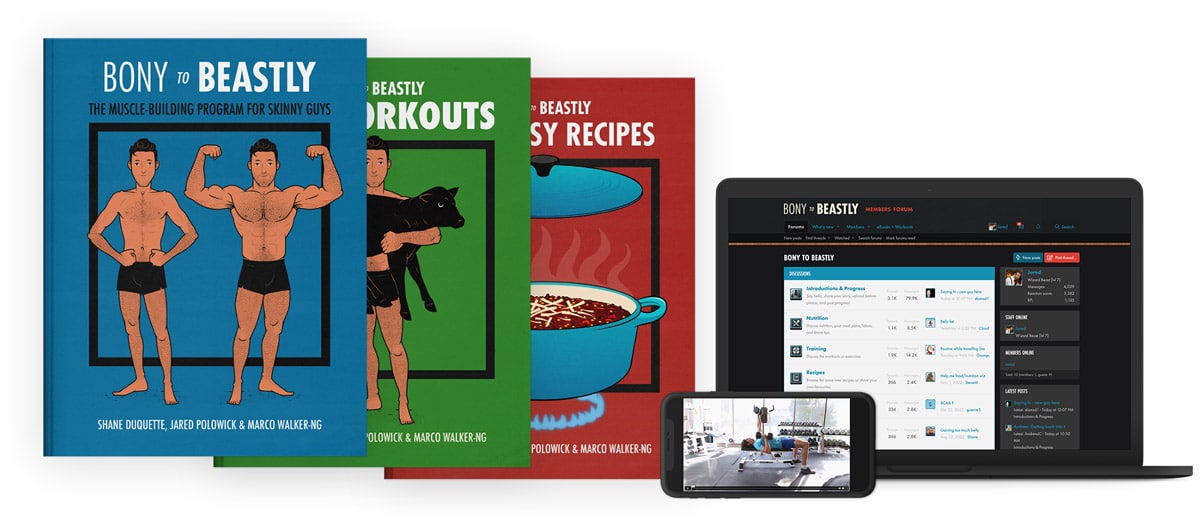
Should You Lift More Weight or Do More Reps to Build Muscle?
The top search result for this question is wrong, and it’s bugging me. There’s this old myth that heavier weights are better for building muscle while lighter weights are better for gaining endurance. That’s not quite right.
Both low-rep and high-rep sets can be equally good for building muscle. Anywhere from 4–40 reps per set stimulates a similar amount of muscle growth. Doing 6–20 reps tends to be a little easier and more efficient. Most bodybuilders lift right in the middle, favouring 8–12 reps.
However, different rep ranges provoke slightly different adaptations. The best way to build muscle is to take advantage of both. A balanced muscle-building program will use a mix of heavier weights and higher reps. More on that in a moment.
This begs another question: when you progressively overload your exercises, should you focus on adding more weight or adding more reps? Both can be equally good for building muscle. It all depends on what exercise you’re doing and what you’re trying to accomplish.

The Adaptations from High Reps vs Low Reps
When you challenge your muscles, you provoke an adaptation. The type of adaptation you get depends on how you challenge your muscles. When you challenge the strength of your muscles, they grow stronger. When you challenge the endurance of your muscles, they grow fitter. In both cases, they grow.
Doing more reps is better for improving your muscular endurance and work capacity. You’ll do a better job of developing your slower-twitch muscle fibres. You can even get cardiovascular adaptations, such as building new blood vessels feeding into your muscles. You’ll also get better at converting waste products (such as lactate) into energy.
Endurance adaptations are especially useful if you’re trying to get better at using your muscles for longer. Building greater muscular endurance will help you run, swim, bike, and row faster and further. You’ll recover more quickly between sets, too.
Heavier weights are better for gaining maximal strength. If you want a bigger bench press or deadlift 1-rep max, it pays to spend some time doing 3–5 reps per set, giving you the coordination you need to lift more weight for a single repetition.
Lifting heavy weights grows your fast-twitch muscle fibres and improves their ability to contract more forcefully, giving you greater strength and explosivity, thus helping you jump higher, sprint faster, and punch harder.
How Many Reps Should You Do Per Set?
Decades ago, when all the old textbooks were being written, there was this idea that 1–5 reps was best for gaining muscle strength, 8–12 reps was best for gaining muscle size, and 15+ reps was best for developing muscle endurance. That isn’t quite wrong, but it’s much too narrow.
In a recent systematic of all the relevant studies, the researchers found that doing anywhere from 6–20 reps per set stimulated the same amount of muscle growth (study). Plenty of research shows similar amounts of muscle growth while doing anywhere from 4–40 reps per set (full explanation).
But there’s a catch. The amount of weight on the bar might not matter very much, but the amount of weight you lift per workout often does, especially with low-rep sets. Consider someone lifting 225 pounds for 3 reps (775 pounds lifted) versus someone lifting 175 pounds for 10 reps (1750 pounds lifted). That’s a huge difference in tonnage. That difference can matter (full explanation).
My favourite example of tonnage is from a study by Schoenfeld and colleagues (study). Both groups lifted the same total amount of weight—the same training volume. However, they used different rep ranges to get there. Here are the results:
- One group did 7 sets of 3 reps: It took them 70 minutes to finish their workouts, their joints ached by the end, and some of them got mild injuries.
- The other group did 3 sets of 10 reps: They finished their workouts in 17 minutes, they felt fresh, and they were eager to do more.
The first group gained more strength, and the second group surely gained more endurance, but both groups gained the same amount of muscle. If you wanted both types of adaptations and even more muscle growth, you could do 3 sets of 3 reps plus 3 sets of 10 reps. That’s what powerbuilders do.
Very high-rep sets have a very different problem. Metabolites accumulate in your muscles faster than you can clear them, creating an intense burning sensation. At 20 reps, the pain is usually manageable. At 40, the pain can be so intense it makes you nauseous, especially on big compound exercises. The last time I tried a 40-rep set of squats to failure, I vomited.
Should You Add Weight or Reps?
You can stimulate muscle growth with anywhere from 4–40 reps. That means unless you’re doing fewer than 4 reps per set, you’re free to add weight. And until you’re doing 40 reps per set, you can always add more reps. But there’s some nuance to it.
When you add reps, the sets can become more painful. That isn’t much of an issue when bringing your bench press from 8 to 12 reps, but it can absolutely be an issue when going from 30 to 35 push-ups.
On the other hand, it’s hard to add weight to some exercises. Push-ups are a good example of that. It’s easier to fight for more reps until you get up to around 20 reps per set. From there, you can raise your feet up on a bench and/or add a deficit. At a certain point, you might need to switch over to weighted dips.
It’s also hard to add weight to very light dumbbell exercises. For example, if you’re doing lateral raises with 10-pound dumbbells, the next weight up is probably 15 pounds—a 50% increase in weight. That’s as crazy as going from deadlifting 315 pounds one week to deadlifting 475 the next. Much better to gradually go from 8 reps up to 15 before adding those extra 5 pounds.
With the big barbell exercises, it’s usually easier to add 5 pounds than to eke out an extra rep. In that case, gradually adding weight tends to make for a much smoother progression.
There are a few good approaches to progressive overload:
- Linear progression: Add a little weight to the bar each workout. For example, if you lift 100 pounds this week, you’ll lift 105 pounds next week. This works best for beginners doing big compound lifts. Once you start losing reps, you’ll need a more robust approach.
- Double progression (basic): Add reps until you get a certain number of reps across all sets. For example, if your workout program has you doing 4 sets of 10, you add weight once you get 10 reps in your 4th set. This makes for a good, simple default.
- Double progression (expanded): add reps until you get to the top of a rep range. For example, if your workout program recommends 4 sets of 8–12 reps, you’d start with a weight you can lift for 8 reps, and you’d gradually add reps until you can do 12 reps. Then you’d add enough weight to drop you back down to 8 reps. This works well for lighter isolation exercises.
- Double progression (Reps in Reserve): Lift close to failure on every set, adding weight when the first set gets too high (e.g. >12 reps) and removing weight if the last set gets too low (e.g. <8 reps). This allows you to lift with the same reps in reserve on each set.
Conclusion
If your main goal is to build muscle, you can lift anywhere in the 4–40 rep range. Low-rep sets aren’t quite as efficient, though, and high-rep sets can be excruciating. Doing 6–20 reps per set is often easiest. 8–12 makes for a perfectly good default.
However, both low-rep and high-rep sets stimulate muscle growth via slightly different pathways and offer different secondary benefits. So it’s even better if you use a mix of rep ranges. For example, 6-rep sets of overhead presses and 15-rep sets of lateral raises. You’ll have an easier time building muscle, and you’ll build a more balanced physique.
A good muscle-building program needs progressive overload, whether that’s adding more weight or more reps. A good default is to stick with the same weight until you get your target reps across all your sets. For example, stick with 100 pounds until you can do 12 reps for 4 sets. Then add 5 pounds, and work your way back up to 12 reps.

If you want us to walk you through the entire bulking process, check out our Bony to Beastly (men’s) program or Bony to Bombshell (women’s) program. They include a 5-month customizable workout routine, a full bulking diet plan, a bulking recipe book, a deep dive into lifestyle and fitness, and coaching from us. Your results are fully guaranteed.

